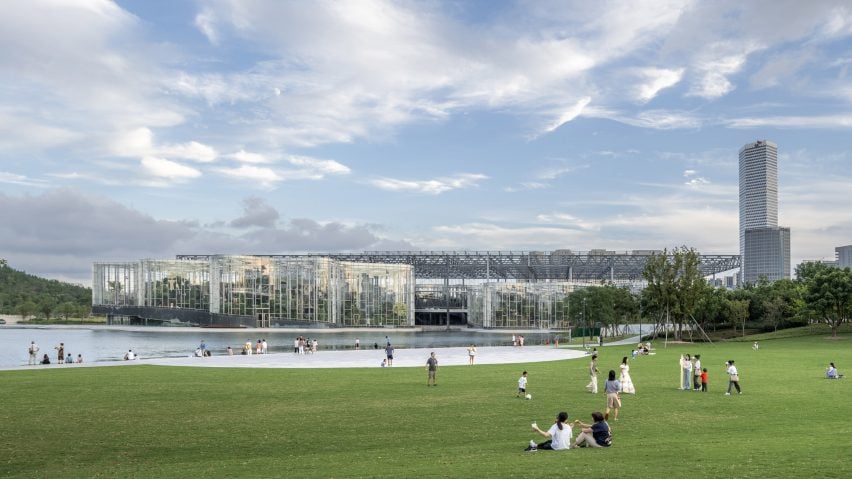Austrian studio Delugan Meissl Associated Architects has completed the Expo Cultural Park Greenhouse in China, engulfing a disused steelworks with a mass of curved glass pavilions.
The 35-metre-tall greenhouse is one of the main attractions in the newly-opened southern section of the Expo Park, built on the former industrial area of Pudong in Shanghai.
It is flanked by a pair of artificial hills built on top of a multi-storey car park and shrouded with 7,000 trees and man-made waterfalls.
Before it was remodelled into the Expo Park in 2010, the inner-city site was occupied by a coal-fired power plant and steelworks. As part of the overhaul, Delugan Meissl Associated Architects (DMAA) was required to retain an industrial factory on the site.
The Vienna-based studio utilised its steel grid as a superstructure and trellis for the undulating glass, steel and aluminium forms of the 41,000-square-metre greenhouse.
"The geometries grow organically in between and around the strict existing grid, performing a vivid and natural silhouette that respects and never touches the remaining framework," studio founder Roman Delugan told Dezeen.
According to DMAA, the contrast between the rigid geometry of the grid and the organic curved greenhouse reflects the site's juxtaposition of nature and industry, informed by the Chinese yin-yang symbol.
The Expo Cultural Park Greenhouse is composed of an entrance building and three distinct pavilions themed around different climates. The first pavilion mimics the arid environment of a desert, complete with artificial dunes and canyons, and filled with drought-tolerant plants.
Its second pavilion is a lush tropical rainforest complete with swamps, waterfalls and tropical vegetation while the third features flower gardens and doubles up flexible space for travelling exhibitions.
Highlights of the gardens include specimens such as the saguaro cactus – one of the tallest in the world – poisonous upas trees and the baobab "tree of life".
The tropical rainforest and flower garden greenhouses are designed for natural ventilation, with openings around the facades and roof areas.
As Shanghai has high humidity in spring and summer, the desert greenhouse is not naturally ventilated but has "openable inlets" should the plants need a fresh air supply.
Visitors can follow a network of pathways through the pavilions and climb up to a terrace above, greeted by panoramic views over the adjacent lake and the rest of the park.
Shanghai's Expo Culture Park began construction in September 2017 and the northern section opened to the public in December 2021.
Austrian studio was founded in 1993 by Delugan and Elke Delugan-Meissl. The studio recently hit the headlines after being officially named as urban planner for phase one of The Line megacity, working alongside Gensler and Mott MacDonald.
Earlier this year, we published an article asking if it was time for studios to walk away from the project, which forms part of the controversial Neom development and has been widely criticised on sustainability and human rights grounds.
In 2021, the studio completed work on a botanical garden complex in Taiyuan, China, featuring three domed greenhouses positioned on or alongside an artificial lake.
The photography is by CreatAR.

